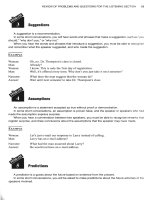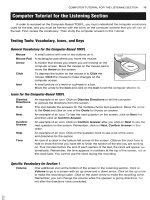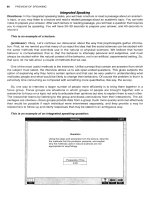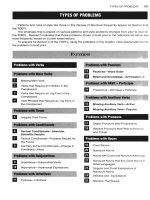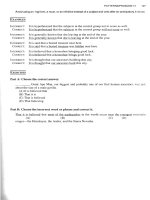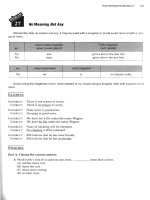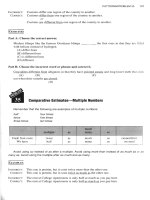Tài liệu How to prepare for the toefl part 8 doc
Bạn đang xem bản rút gọn của tài liệu. Xem và tải ngay bản đầy đủ của tài liệu tại đây (518.64 KB, 10 trang )
REVIEW OF PROBLEMS
AND
QUESTIONS FOR
THE
I-ISTENING SECTION
65
A
suggestion
is a recommendation.
In some short conversations, you will hear words and phrases that make a suggestion, such as "you
should," "why don't you," or "why not."
When you hear the words and phrases that introduce a suggestion, you must be able to recognize
and remember what the speaker suggested, and who made the suggestion.
Woman:
Oh, no.
Dr.
Thompson's class
is
closed.
Man: Already?
Woman:
I
know. This is only the first day of registration.
Man: Well, it's offered every term. Why don't you just take
it
next semester?
Narrator: What does the man suggest that the woman do?
Answer: Wait until next semester to take
Dr.
Thompson's class.
a
Assumptions
An
assumption
is a statement accepted as true without proof or demonstration.
In some short conversations, an assumption is proven false, and the speaker or speakers who had
made the assumption express surprise.
When you hear a conversation between two speakers, you must be able to recognize remarks that
register surprise, and draw conclusions about the assumptions that the speaker may have made.
Woman: Let's just e-mail our response to Larry instead of calling.
Man:
Lariy has
an
e-mail address?
Narrator: What had the man assumed about Larry?
Answer: He would not have an e-mail address.
A
prediction
is a guess about the future based on evidence from the present.
In some short conversations, you will be asked to make predictions about the future activities of the
speakers involved.
66
REVIEW
OF
LISTENING
When you hear a conversation between two speakers, you must listen for evidence from which you
may draw a logical conclusion about their future activities.
Man: Could you please book me on the next flight out to Los Angeles?
Woman:
I'm sorry,
sir.
Continental doesn't fly into Los Angeles. Why don't you
try
Northern
or Worldwide?
Narrator: What will the man probably do?
Answet:
He will probably get a ticket for a flight on Northern or Worldwide Airlines.
a
Implications
Implied
means suggested, but not stated. In many ways, implied conversations are like prediction conversa-
tions.
In some short conversations, you will hear words and phrases or intonations that will suggest how
the speakers felt, what kind of work or activity they were involved in, or where the conversation may
have taken place.
When you hear a conversation between two speakers, you must listen for information that will help
you draw a conclusion about the situation.
Woman: Where's Anita? We were supposed to go to the library to study.
Man:
Well, here is her coat, and her books are over there on the chair.
Narrator: What does the man imply about Anita?
Answer:
Anita has not left for the library yet.
A
problem
is a situation that requires discussion or solution.
In some short conversations, you will hear the speakers discuss a problem.
When you hear a discussion between two speakers, you must be able to identify what the problem
is. This may be more difficult because different aspects of the problem will also be included in the con-
versation.
Woman:
It
only takes two hours to get to New York, but you'll have a six-hour layover between
flights.
Man: Maybe you could
try
routing me through Philadelphia or Boston instead.
REVIEW
OF
PROBLEMS AND QLlESTlONS FOR
THE
LISTENING SECTION
67
Narrator:
What is the man's problem?
Answer: His flight connections are not very convenient.
Topics
A
topic
is
a main theme in a conversation or in a piece of writing.
In some short conversations, the speakers will discuss
a
particular topic.
When you
hear
a conversation, you must be able to identify the main topic from among several sec-
ondary themes that support the topic.
Man: Tell me about your trip to New York.
Woman:
It was great! We saw the Statue of Liberty and the Empire State Building and all of the
tourist attractions the first day, then we saw the museums the second day and spent the
rest of the time shopping and seeing shows.
Narrator:
What are the man and woman talking about?
Answer: The woman's trip.
Types of Problems in Longer Conversations
a
Academic Conversations
Academic conversations
are conversations between students and professors
or
other academic
personnel on a college or university campus.
In some longer conversations, you will hear an academic conversation between two speakers.
When you
hear
a
conversation, you must be able to summarize the main ideas. You may also be
asked to recall important details.
Joe:
Hi, Dr. Watkins. Are you busy?
Dr. Watkins: Oh, hello, Joe. Come in.
Joe: Thanks. You've probably graded our midterms.
Dr. Watkins: Just finished them. Frankly,
I
was surprised that you didn't do better on it.
Joe:
I
know. I had two midterms on the same day, and I didn't organize my time very well.
I
spent too much time studying for the first one, and then
I
ran out of time to study for
yours.
Dr. Watkins: I see.
Joe: So
I
was wondering whether
I
could do a project for extra credit to bring my grade
back up. I'm sure
I
have a
B
or even a C after that midterm, but before that
I
had a
solid
A.
68
REVIEW
OF
LISTENING
Dr. Watkins:
Joe:
Dr.
Watkins:
Joe:
Dr. Watkins:
Joe:
Question:
Answer:
Did you have anything in mind for your project?
Well,
I
was thinking that I could develop a reading list, using the main topics from the
midterm. And then, if the list looks okay to you,
I
could write a summary of each of
the readings. But, if you don't like that idea, I'd be happy to do any project you would
approve.
Actually, that sounds like a good plan. In fact,
I
have a reading list that might work for you.
Better yet.
Good.
If
you do summaries for all of these articles, the extra points should put you
back on track for an
A.
Thanks. Thanks a lot.
What is Joe's problem?
His grade in the course is low because of his midterm.
Question:
Why didn't Joe do better on the midterm?
Answer: He spent too much time studying for a midterm for another class.
Question:
What does Joe want to do?
Answer:
He wants to complete some additional assignments to earn extra points.
Question:
How does Professor Watkins respond to Joe's proposal?
Answer: She is helpful.
Types of Problems
in
Talks
and
Lectures
Class
discussions
are conversations that occur in classrooms.
In some talks, you will hear a class discussion between two, three, or more speakers.
When you hear a discussion, you must be able to summarize the important ideas. You will usually
NOT
be required to remember small details.
It will help you to audit some college classes.
Miss Richards: Good morning. My name is Miss Richards, and I'll be your instructor for Career
Education
100.
Before we get started, I'd appreciate it if you would introduce your-
selves and tell us a little bit about why you decided to take this class. Let's start here
Bill: I'm Bill Jensen, and
I'm
a sophomore this term, but
I
still haven't decided what to
major in.
I
hope that this class will help me.
Miss Richards: Good, I hope so, too. Next.
Patty: I'm Patty Davis, and I'm majoring in foreign languages, but
I'm
not sure what kind of
job
I
can get after I graduate.
Miss Richards: Are you a sophomore, too, Patty?
Patty:
No. I'm a senior. I wish I'd taken this class sooner, but I didn't know about it until this
term.
REVIEW OF PROBLEMS
AND
QUESTIONS FOR THE LISTENING SECTION
69
Miss Richards: Didn't your advisor tell you about it?
Patty: No. A friend of mine took it last year, and it helped her a lot.
Miss Richards: How did you find out about the course, Bill?
Bill:
The same way Patty did. A friend of mine told me about it.
Question: In what class does this discussion take place?
Answer: Career Education.
Question: What are the two students talking about?
Answer: They are introducing themselves.
Question: Why is the woman taking the course?
Answer:
To help her find a job after graduation.
Question: How did the students find out about the course?
Answer:
From friends who had taken it.
Academic
talks
are short talks that provide orientation to academic courses and procedures.
In some talks, you will hear academic talks on
a
variety of college and university topics.
When you hear a talk, you must be able to summarize the main ideas. You must also be able to
answer questions about important details. You will usually not be asked to remember minor details.
Since we'll be having our midterm exam next week, I thought
I'd
spend a few minutes talk-
ing with you about it.
I
realize that none of you has ever taken a class with me before, so you
really don't know what to expect on one of
my
exams.
First, let me remind you that I have included a very short description of the midterm on the
syllabus that you received at the beginning of the semester. So you should read that.
I
also rec-
ommend that you organize and review your notes from all of our class sessions. I'm not saying
that the book is unimportant, but the notes should help you to identify those topics that we cov-
ered in greatest detail. Then, you can go back to your book and reread the sections that deal with
those topics. I also suggest that you take another look at the articles on reserve in the library.
They have information in them that is not in the book, and although we didn't talk much about
them in class,
I
do feel that they are important, so you can expect to see a few questions from the
articles on the exam. Oh, yes, I almost forgot. Besides the twenty-five objective questions, there
will be five essay questions, and you must choose three.
Question:
What does the speaker mainly discuss?
Answer: The midterm exam.
70
REVIEW
OF
LISTENING
Question: When will the students take the exam?
Answer: Next week.
Question:
According to the professor, what should the students do to prepare?
Answer: Study their notes, the articles on reserve, and appropriate sections of the book.
Question:
What is the format of the exam?
Answer: Twenty-five objective questions and five essay questions.
Lectures
are short talks that provide information about academic subjects. They are like short lec-
tures that might be heard in
a
college classroom.
In
some talks, you will hear academic information in a short lecture.
When you hear a lecture, you must be able to summarize the important ideas. You must also be
able to answer questions that begin with the following words:
who, what, when, where, why?
It will help you to listen to documentary programs on radio and television. Programs on educational
broadcasting networks are especially helpful. Listen carefully. Ask yourself questions to test your ability
to remember the information.
The vast array of fruits presents a challenge for scientists who try to classify them, but they are
usually classified into several types according to the origin of their development. Simple fruits
are derived from flowers with just one pistil. Here is a diagram of a simple hit. Some of the
most obvious examples include cherries, peaches, and plums, but coconuts are also simple
fruits.
simple
REVIEW OF PROBLEMS AND QUESTIONS FOR
THE
I-ISTENING SECTION
71
As you can see, the second classification of fruits, aggregate fruits, differs from simple fruits in
that each flower has several pistils. Examples of aggregate hits are blackberries, raspberries,
and strawberries. Now, let's look at a diagram of an aggregate fruit.
aggregate
The third type, a multiple fruit, develops from a group of flowers that grow in clusters. When
the walls of the pistils thicken, then they bond and become incorporated into a single fruit. The
classic example of this type is the pineapple, but figs are also classified as multiple fruits. Here
is a diagram of a multiple fruit for comparison with the other two types.
multiple
Selective breeding creates new varieties of fruit, usually larger, juicier, and more appealing than
the smaller natural fruits. However, even laboratory fruits seem to adhere to this general typology.
Okay, I'm going to put some specimens into the lab for you to examine. There will be three
trays-the first with samples of simple fruits, the second with samples
of
aggregate fruits, and
the third with samples of multiple fruits. Please examine both the flowers and the hits them-
selves, and this is important-please look at the three trays in this order-simple fruits, aggre-
gate fruits, and multiple fruits.
72
REVIEW
OF
LISTENING
Multiple-Choice Questions
Paper-Based TOEFL
1.
What is the lecture mainly about?
GD
Laboratory assignments with fruit
'a
Selective breeding of fruit
O
Basic classifications of fruit
a
A
definition of fruit
2. Which of the fruits is an example of a
multiple fruit?
.
GD
Pineapples
a
Cherries
O
Strawberries
a
Blackberries
3.
What distinguishes laboratory fruits from
natural fruits?
GD
They do not taste as sweet as natural
fruits.
Laboratory fruits tend to be larger.
O
They are not classified the same way
as natural fruits.
Laboratory fruits are bred with more
pistils.
4.
Which of the following fruits will
NOT
be
placed into the first tray in the lab?
GD
Coconuts
a
Plums
O
Peaches
a
Raspberries
Computer-Based TOEFL
What is the lecture mainly about?
0
Laboratory assignments with fruit
0
Selective breeding of fruit
a
0
Basic classifications of fruit
0
A definition of fruit
Which of the fruits is an example of a
multiple fruit?
a
0
Pineapples
0
Cherries
0
Strawberries
0
Blackberries
What distinguishes laboratory fruits from
natural fruits?
0
They do not taste as sweet as natural
fruits.
a
0
Laboratory fruits tend to be larger.
0
They are not classified the same way
as natural fruits.
0
Laboratory fruits are bred with more
pistils.
Which of the following fruits will
NOT
be
placed into the first tray in the lab?
0
Coconuts
0
Plums
0
Peaches
a
0
Raspberries
Answer
Sheet
1.GDcD.a
2.0aoa
3.CDOOaD
4.CDaoo
TYPES
OF
QUESTIONS
73
Computer-Assisted Questions
Two-Answer Questions.
On some of the computer-assisted questions, you will be asked
to
select
two answers. Both answers must be correct to receive credit for the question.
According
to the professor, whlch of the fru~ts are classlf~ed as s~mple fru~tsv
Click
on
two
answers
[XJ
Chernes
Blackberr~es
[XI
Peaches
Apples
Visual Questions.
On some of the computer-assisted questions, you
will
be asked
to
select a
visual. The visual may
be
a picture,
a
drawing, or a diagram.
Select the drawing that best represents an aggregate fruit
Cfick'on"
a&aMii.
74
REVIEW
OF
LISTENING
Sequencing Questions.
On some of the computer-assisted questions, you will be asked to
sequence events in order.
The
events could be historical events or the steps in a scientific process.
All answers must be sequenced correctly to receive credit for the question.
The professor briefly describes the way that students should examine the trays of fruit.
I
Summarize the directions
by
putting the trays into order.
Click on an answer. then click on the space
whare
it
belongs.
Use each answer only once.
Multiple Fruits Aggregate Fruits
simple fruits
I
Simple fruits
Classification Questions.
On some of the computer-assisted questions, you will be asked to clas-
sify information by organizing it in categories.
How should the following fruits be classified?
Cfick on a sentence. then click on the space where
it
belbngs.
Use
each
sentence only once.
.
Fruks wtth clusters of flowers.
of flowers.
